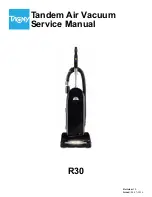
10
10
packs, and drain the liquid into a suitable receptacle or drain.
wet vacuuming, turn the machine off and remove all battery
packs. Empty the tank, clean and dry the inside and outside
before storage.
BATTERIES
Battery packs which have not been used for some time should
be recharged before use.
Temperatures in excess of 50°C reduce the performance of
the battery pack. Avoid extended exposure to heat or sunshine
(risk of overheating).
The contacts of chargers and battery packs must be kept clean.
For an optimum life-time, the battery packs have to be fully
charged, after used.
To obtain the longest possible battery life remove the battery
pack from the charger once it is fully charged.
For battery pack storage longer than 30 days:
•
Store the battery pack where the temperature is below
27°C and away from moisture.
•
Store the battery packs in a 30% - 50% charged condition.
•
Every six months of storage, charge the pack as normal.
TRANSPORTING LITHIUM BATTERIES
Lithium-ion batteries are subject to the Dangerous Goods
Legislation requirements.
Transportation of those batteries has to be done in accordance
with local, national and international provisions and regulations.
■
The user can transport the batteries by road without further
requirements.
■
Commercial transport of Lithium-Ion batteries by third
parties is subject to Dangerous Goods regulations.
Transport preparation and transport are exclusively to
be carried out by appropriately trained persons and the
process has to be accompanied by corresponding experts.
When transporting batteries:
■
Ensure that battery contact terminals are protected and
insulated to prevent short circuit.
■
Ensure that battery pack is secured against movement
within packaging.
■
Do not transport batteries that are cracked or leak.
Check with forwarding company for further advice
BATTERY PACK PROTECTION
The battery pack has overload protection that protects it
from being overloaded and helps to ensure long life. Under
extreme stress the battery electronics switch off the machine
automatically. To restart, switch the machine off and then
on again. If the machine does not start up again, the battery
pack may have discharged completely. In this case it must be
recharged in the battery charger.
MAINTENANCE
See figure 12-14.
WARNING
Always remove all battery packs before removing the power
head from the tank.
1. Verify that no battery pack is inserted in the battery ports.
2. Disconnect the hose from the vacuum (Fig 13).
3. Undo the latches and remove the power head from the
tank (Fig 14).
4. Clear all dirt or debris from the tank and hose (Fig 15 ).
5. Clean the foam filter by washing it with water and mild
soap.
6. Check the hose and attachments to verify that they have
not been damaged.
INSTALLING AND REMOVING HEPA FILTER
See figure 5.
1. Verify that no battery pack is inserted in the battery ports.
2. Remove power head and place in upside down position.
3. Install the HEPA filter over the filter cage with the flat end of
the filter towards the vacuum power head. Carefully push
filter in until it stops against the power head.
4. Install the filter cap. Turn the locking knob clockwise to lock
the filter cap in place.
See figure 15-16.
1. Unlock and remove the filter cap by tuning cap counter
clockwise.
2. Carefully hold and pull the HEPA filter up for removal.
3.
NOTE:
and cap attached, the motor will burn out and the warranty will
be voided.
NOTE:
quality materials designed to stop small dust particles. The
when removing it for replacing it. Check the HEPA cartridge
through and out of the cleaner.
it immediately.
off. For optimal performance it is recommended to regularly
To clean, either dust off the filter by gently tapping or
brushing direct off. Alternatively wash it with clean water. If
washed, please allow to air dry for 24hours before installing
back onto the unit.






























